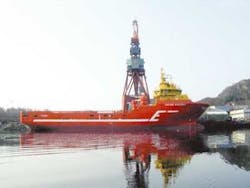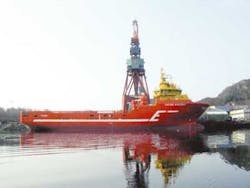Statoil charters LNG vessels for clean technology benefits
Nick Terdre
Contributing Editor
Two LNG-powered supply vessels due to come into operation next year in the Norwegian offshore sector will bring significant benefits in terms of reduced greenhouse gas emissions. The inno-vative move has been made possible by Statoil, which has given separate 10-year charters for the vessels to shipowners Eidesvik and Møk-ster Shipping.
null
The vessels, the hulls of which are being built in Romania and Poland, will be outfitted at the Kleven yard at Ulsteinvik in western Norway. Eidesvik was due to take delivery of the first in April 2003 and Møkster the second in July, according to John Stangeland, marketing manager at Eidesvik.
Compared with a conventional diesel-electric supply vessel of the same design, the LNG ships offer reductions of 82-84% in nitrogen oxide emissions and 20-25% in carbon dioxide emissions. Based on a typical work pattern, the savings amount to 180-200 metric tons of NOx and 5,000-6,000 metric tons of CO2 annually per vessel. While Statoil plans to use the NOx reduction as a credit to be set against its land-based emissions, the initiative also offers interesting possibilities for the shipping sector, which is a major contributor to Norway's NOx emissions.
The vessels are being built to the VS 4403 LNG PSV design developed by Eidesvik, Statoil, and the Norwegian ship designer Vik & Sandvik. To achieve an optimal design, which incorporates both a large LNG tank as well as diesel propulsion in case of problems with the LNG supply, the design was developed from scratch.
Eidesvik worked closely with the classification society DNV and the Norwegian Maritime Directorate, the regulatory authority, to have the design accepted. DNV carried out an extensive program of risk analysis before concluding that the risk level for the LNG-fuelled vessel was no higher than that for a diesel-fuelled vessel. The NMD drew up a new regulation for gas-fuelled cargo vessels.
Safety was clearly a foremost concern. The LNG tank, which can hold 223 metric tons of fuel, is located midships – the safest place, in the event of a collision – and has extensive protective structures built around it. The bulkheads have hatches that will blow open in the event of an explosion.
To meet Statoil's desire for large cargo capacity, the vessel is somewhat bigger than a large conventional supply ship, with 6,000 dwt capacity and 1,030 sq m of free deck space, compared with 4,000-4,500 dwt and 850-1,000 sq m.
The vessel will deliver performance on a par with that of conventional supply vessels. It is expected to have a transit speed of around 18 kn, compared with 15-16 kn. Fitted with two bow thrusters and one azimuth thruster fore and two aft, it will have very good maneuverability.
In other respects it compares with the most advanced vessels, having DP II AUTR dynamic positioning, the Comfort class notation for the working environment, and the Clean notation for minimal emissions to sea and air.
Given current environmental concerns, the LNG supply vessel is definitely a bridge into the future, Stangeland says. The concept has aroused a lot of interest in the industry, but companies want to see how it works in practice before deciding whether to follow in Statoil's footsteps. Eidesvik expects its own experience from the project to lead to gains when it comes to designing and operating second-generation LNG supply vessels.

